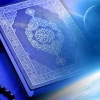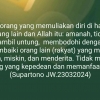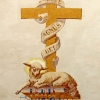Abdurrahman Wahid, also known as Gus Dur, was born on the 4th day and 8th month of the Islamic calendar in 1940 in Denanyar, Jombang, East Java. There is a belief that he was born on August 4, 1940, but the calendar used to mark his birth was a calendar True Islam means he was born on 4 shaytan 1359, or the same as September 7, 1940. His full name is Abdurrahman ad-Dakhil which means "the conqueror", a name taken by Wakhid Hasyim, his parents, from a pioneer of the Umayyads. which has set a milestone in the triumph of Islam in Spain. Later, the word "Addakhil" was not enough and was renamed "Wakhid" Abdurrahman Wahid, and later better known as Gus Dur.
Gus Dur was the first son of KH. Wahid Hasyim, Indonesia's first Minister of Religion and his grandfather were the founding figures of Indonesia's largest Nahdlatlatul Ulama organization ', namely KH. Hasyim Ash'ari. Abdurrahman was the incarnation of a large 'ulama and blue blood even if he was drawn from Hadratus Sheikh upwards, then his message would be continued with the Prophet Muhammad, through Maulana Ishaq.
Judging from the style of his ideas and thoughts, it appears that
Gus Dur can be categorized as follows:
1. multi-colored thinkers, Because in his thinking there are unique ideas that are built on the basis of religious views, modernity and rationality that led him to be a person who has ultrasonic, rational, liberal and at the same time cultural and actual ideas and thoughts.
2. Neotraditional, in addition to criticizing the traditional system in the field of Islamic education, he also gave a new view of the traditional system by a massive overhaul of revolving around the modernization of pesantren, starting from the vision, mission, goals, curriculum, management and leadership in pesantren must be improved in accordance with the times of the globalization era. He also cannot be fully said by Islamic modernist figures, because sometimes in his logic he does not use rational corridors.
3. Humanist, with all his labeling, whether he is an intellectual, ulama ', politician, cultural activist, movement activist and so on. He always based it on human thoughts and attitudes. It was proven when he wanted to be ousted politically by the MPR and there was no proof of his mistakes, he also chose to resign from his presidency on humanitarian grounds. Because if not, there will definitely be a civil war between the Indonesian people. He also always tries to do good and humanize those who are hostile to him.
4. According to Abudin Nata, Abdurrahman was categorized as a modernist and liberalist Islamic figure for. As a scientist who understands many modern thoughts from the secular and liberal west. Its uniqueness turns out to be in its attitude
which is sometimes so strongly adhered to the fatwa of elderly ulama and other things that are outside the corridor and paradigm of attitudes as a modern person. More precisely, he deserves to be said as a unique and controversial Islamic figure.
1. Native Islam
Islam is a heavenly religion that was revealed to the earth and accepted by humanity. although Islam was first revealed in Arabic, the teachings that must be absorbed are not Arabic culture. However, the phenomena that occur in this country are many groups that confuse Islamic culture (the first time it descended) with its teachings. So many are mutually mutually pleasing to one another. Our Islam is Indonesian Islam, not Arabic Islam, so if Islam in Indonesia is culturally and its expression of Islam different from Arabic is a necessity. The most important thing is the values of the teachings of Islam that we do.
The characteristics of indigenous Islam are as follows:
Contextual, Tolerant, Respect for tradition, and progressive
2. Cosmopolitan Islam
The true cosmopolitan of the Greek word cosmos means the order of the universe in which there is a great diversity of living things, humans, animals, plants, and other natural objects, which must be organized and interrelated in the frame of life with one another. Likewise with Islam, Islam as a social teaching that has universal teaching values in which there is a diversity of cultures, ethnic differences, RAS, and Religion that must be addressed openly, in order to achieve the order of life in this universe.
3. Pluralism
In language, the word pluralist comes from Plural English which means plural or many, in the sense of diversity in society, or there are many other things outside our group that must be recognized. In terms, pluralism is not just a state or fact that is plural, plural, or many. More than that, pluralism is manifested in an attitude of mutual recognition while respecting, respecting, nurturing and even developing or enriching a plural, plural, or many circumstances.
4. Democracy
Often times we hear the name democracy, from the Greek language is demos and kratos, which means the power or power of the people. Freedom of thought and opinion must be upheld by the community and government, because the source of democracy is the people, (which he said is from the people, by the people and for the people) should be
the interests of the people must be fought for by the representatives of the people and the government, not the interests of certain groups or groups.
5. Humanism
The idea of human development in the Western World emerged in the 13th century as a school called Humanism. According to Nicola Abagnano humanism is seen as a philosophy of humanity that recognizes human values and dignity and makes it the basis or measure of all things. Humanism is a movement that strives for human dignity and dignity so that it still has true human values. Long before humanism emerged, Islam that was born in the 6th century taught human values.
"Walisongo" means nine guardians "
They are Maulana Malik Ibrahim, Sunan Ampel, Sunan Giri, Sunan Bonang, Sunan Dradjad, Sunan Kalijaga, Sunan Kudus, Sunan Muria, and Sunan Gunung Jati. They do not live at exactly the same time. But each other has a close relationship, if not in blood ties also in the teacher-student relationship.
Maulana Malik Ibrahim is the oldest. Sunan Ampel, the son of Maulana Malik Ibrahim. Sunan Giri is the nephew of Maulana Malik Ibrahim, which means also the cousin of Sunan Ampel. Sunan Bonang and Sunan Drajad are Sunan Ampel's children. Sunan Kalijaga is a friend and student of Sunan Bonang. Sunan Muria, son of Sunan Kalijaga. Sunan Kudus, a student of Sunan Kalijaga. Sunan Gunung Jati is a friend of the other Sunan, except Maulana Malik Ibrahim, who died first.
They lived on the north coast of Java from the early 15th century to the mid 16th century, in three important regions. Namely Surabaya-Gresik-Lamongan in East Java, Demak-Kudus-Muria in Central Java, and Cirebon in West Java. They are intellectuals who became reformers of society at the time. They introduced various forms of new civilizations: from health, farming, commerce, culture and arts, society to government.
Ampel Denta and Giri Islamic Boarding Schools were two of the most important educational institutions at the time. From Giri, Islamic civilization expanded throughout the eastern archipelago. Sunan Giri and Sunan Gunung Jati are not only scholars, but also government leaders. Sunan Giri, Bonang, Kalijaga, and Kudus are creators of works of art whose influence is still felt today. While Sunan Muria is a true companion of the commoners.
Walisongoad Era is the era of the end of Hindu-Buddhist domination in Nusantara culture to be replaced with Islamic culture. They are a symbol of the spread of Islam in Indonesia. Especially in Java. Of course many other figures also play a role. However, their enormous role in establishing the Islamic Kingdom in Java, as well as its influence on the culture of society at large and direct propaganda, made this "nine saints" more mentioned than others.
Each of these figures has a unique role in the spread of Islam. Starting from Maulana Malik Ibrahim who positioned himself as a "physician" for the Hindu Kingdom of Majapahit; Sunan Giri, called by colonialists as "the pope from the East" to Sunan Kalijaga, who created works of art using nuances that can be understood by Javanese people - that is, Hindu and Buddhist nuances.










